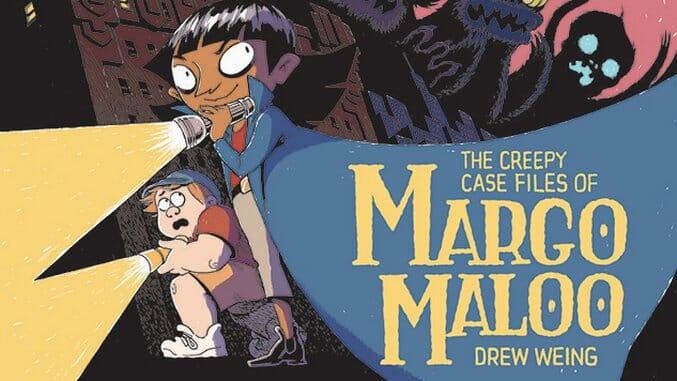Drew Weing Channels ’70s Kids Lit and Philosophical Monsters in The Creepy Case Files of Margo Maloo

We’re currently in an age of wonderful kids’ comics and wonderful grown-up comics, but it’s hard to find sequential art that speaks to both audiences. Drew Weing’s The Creepy Case Files of Margo Maloo, a serialized strip that’s been running since February 2014, is that rare creation that does. Sure, its protagonists are kids and its action never veers past a PG extreme, but its stories are neither dumb nor dumbed-down. An adult can read them for pure pleasure without needing the excuse of a child, and a 6-year-old can read them and thrill to the taste of danger and independence that lie in her future. And both can now enjoy the comic in print as publisher First Second has collected the first three stories in a handsome hardback, released last month.
Weing has never made a comic that works solely on one level, from Set to Sea (a pirate story that’s also about pirate stories) to Flop to the Top (a Toon Books collaboration with his wife, Eleanor Davis, that injects contemporary celebrity culture into a kids’ book about a dog). Margo Maloo is no different. It can be read as a straightforward adventure story about monsters, or readers can appreciate its painstaking and beautifully rendered art, and/or you can exercise your analytical skills and pull out its metaphors about expanding horizons to see the value in other cultures. It’s delicate and thoughtful in a way that very little material for children is. As it turns out, Weing draws a lot of inspiration from the kinds of kids’ books published some decades ago that were similarly unafraid to create a big, dark world for their readers. The cartoonist chatted with Paste about Margo Maloo’s origin, character design, coloring and what makes him put so much on the page.![]()
Paste: Talk to me about character design. Charles is all soft and round, where Margo is full of angles and Kevin sticks out in all directions. How long did it take you to figure out what they should look like?
Drew Weing: Some art school teacher pitched me this idea years ago, and I still hold to it: that if you lined up all of the characters in your comic, and took a marker and blacked in all the details, you still ought to be able to pick each one out instantly from their silhouette.
Margo started as a co-creation between my wife and myself. Years ago, we were trying to come up with a comic we could pitch as a one-page serial to Nickelodeon Magazine, and we came up with this monster mediator character by passing a sketchbook back and forth, tweaking her design and adding details. The serial never happened, but I kept Margo in the back of my mind for years, thinking up new monster details. I eventually realized she needed a sidekick of some type—Margo was much too laconic to properly introduce a new reader to her world. The first sidekick designs were a shrimpy, nervous little kid, but suddenly this chunky, assertive Charles jumped off the page, almost fully-formed. And Kevin materialized from a nosy little neighbor kid I had in Savannah, who really was all elbows and knees.
Paste: How did you design Echo City? If I know you, I’d say you spent a lot of time on that map and you have a pretty good understanding of the whole city even though we only get to see a little bit of it in these three stories. It is definitely not a college town like Athens [where you and I both live]!
Weing: I smooshed together New York and Chicago and all the other big cities that I’ve visited. I’m pretty amazed sometimes that I didn’t end up in one of them, at least for a few years. This way I get to exorcise my Big City FOMO, at least a little bit. I like to do much of my city exploration on foot, so I end up in a lot of weird liminal spaces. Eleanor could tell you about the time we almost ended up late to a medal reception for one of her books, because we got lost in the service tunnels of Chicago’s McCormick Place convention center. I wanted lots of spaces like that in Echo City.

The Creepy Case Files of Margo Maloo Interior Art by Drew Weing
Paste: Your color palette seems nicely worked out: a lot of browns with occasional blues and reds. What’s the philosophy there? Did you try other schemes?
Weing: I didn’t set out to make any sort of pastiche, but I’ve soaked up a lot of ‘60s and ‘70s kids-book color schemes that probably bleed through. I do all my coloring digitally, and you get so many options and shortcuts in Photoshop that colorists often go overboard with shading and highlights and fluorescent color palettes. So I purposefully chose a set of colors at the beginning—purples, tans, reds—that I try to stick to. Also, to get a little handcrafted element into each page, I hand-scribble in each area of color instead of using a shortcut. It takes forever, but gives me a certain meditative feeling, just like those adult coloring books.
-

-

-

-

-

-

-

-

-

-

-

-

-

-

-

-

-

-

-

-

-

-

-

-

-

-

-

-

-

-

-

-

-

-

-

-

-

-

-

-












































